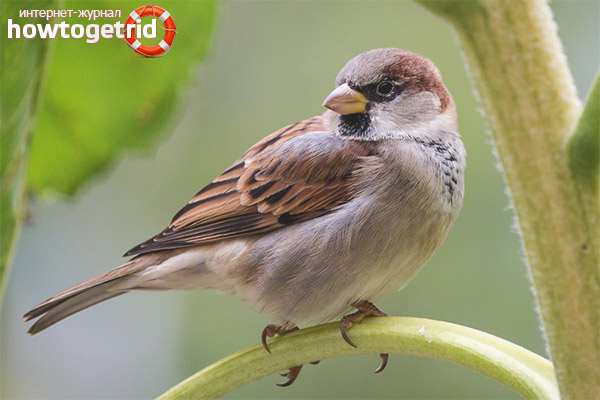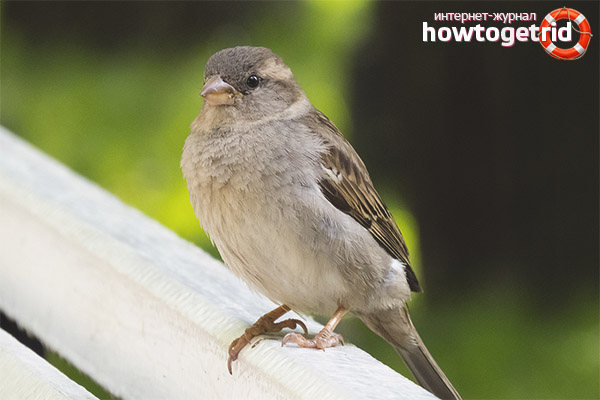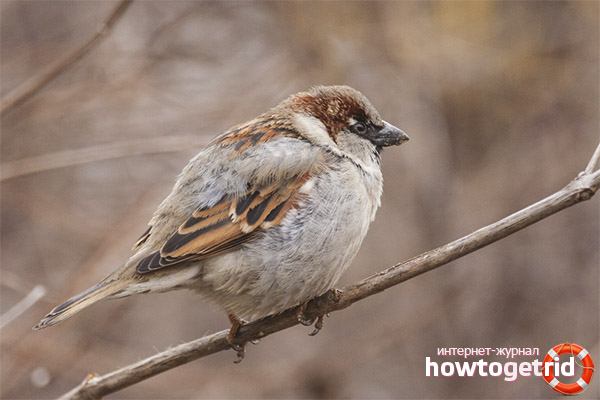The content of the article
House sparrows, as the name implies, are classified as a sparrow family. They are quite common in settlements, prefer to be near people. To date, this bird is considered the most popular among those species that live next to humans. Sparrows are known by their external data even to a child, and you can’t confuse tweets with others. Today we will study everything that affects these feathered representatives of the species.
Description
- Feathered individuals can not boast of impressive size. They grow up to 17 cm in length, but most often there are representatives who grow up to 14 cm in the body. As for the mass, it ranges from 25-40 gr.
- The head is round, large in size, seems disproportionately large in relation to the rest of the body. The beak is wide and strong, canonical, grows to 1.5 cm. Maximum.
- These individuals seem quite strong and strong, given that they have a small mass and dimensions in particular. The tail grows to 5 cm, and the limbs are 3 cm in height.
- Differences in gender are manifested in general terms. Females are slightly smaller than males. The color of the feathers also varies, depending on the gender. Birds in the upper part are always painted in a brownish tint.
- The lower part of the body is gray, light. On the wings there is a faded yellowish edging and longitudinal stripes. In male representatives of the family, the head in the crown area is pigmented with a dark gray color, and under the eyes there are light gray blotches. The neck and chest have a black speck.
- In females, in addition to smaller dimensions, a different color of the crown is also distinguished. She is light, brownish. The same shade of the neck. When the mating season begins, the birds in their plumage become dark. Therefore, some of the characteristics listed above may vary.
Habitat
- Since ancient times, representatives of this pedigree group lived exclusively in the northern part of Europe. But with the onset of the 20th century, the population increased, and the habitat decently expanded. Birds are found in different parts of the planet.
- Especially a lot of them in Eurasia, the exception is perhaps the northeastern and eastern parts of the continent. Many individuals in South America, North America, Australia in the east, South Africa.
- According to their characteristics, sparrows prefer to settle in one place. They choose zones with moderate climatic conditions, enough food.
- Birds are attached to humans and housing, otherwise this species is considered synanthropic. Over the years, family members have adapted to live next to people.
Breeding
- These individuals build nests in pairs, but can also nest colonially. Construction is being implemented in close proximity to human housing. Nests are located in cities and towns.
- If the birds live in the south, then their place of deployment can be distant from people. In such regions, birds build nests in ravines and areas located next to sown fields. They can enjoy cereals at any time.
- Sparrows prefer to nest in openings of stone buildings, as well as in hollows. Some individuals occupy abandoned nests left over from other birds. Birds huddle together once and remain inseparable for life.
- It is worth noting that birds have a short life span.Some of them with great difficulty reach 3 years, although in nature there were 10-year-old representatives of the passerine family.
- The house is built not only by the female; the future father of the offspring helps her. Blades of grass, feathers, straw, etc. are used as building materials. The mating season originates in early spring, so that by the middle of the season the female manages to make the first laying.
- The female gives 4-10 eggs. Incubation continues for 15 days. When the chicks go on feeding, both the female and the male are engaged in this. 10 days after birth, babies already make their first attempts to fly out of the nest. Sparrows are many, because they are prolific. Female for 1 season is able to bring 3 offspring.
Nutrition
- In most cases, the diet of individuals is mainly based on plant foods. As for food of animal origin, birds feed on it only in the spring and during the feeding of offspring.
- Such sparrows love to feast on the seeds of cereal crops. They also eat the waste products that remain after people. In addition, birds love a variety of berries in vineyards and orchards. If individuals do not find food, then they fly to the meadows. In such places, they feed on the seeds of various plants.
The value of sparrows for humans
- It is worth noting that individuals can be both beneficial to humans and equally harmful. The problem is that birds are carriers of various serious infections and diseases. In addition, on their wings are pests that can destroy the entire agricultural crop.
- House sparrows do some harm to almost all poultry. Individuals are carriers of serious diseases in the form of smallpox and diphtheria. Do not get upset ahead of time. In fact, the benefits of such sparrows are much greater.
- An example is the case that occurred in China in 1958. The fact is that the Chinese government ordered the destruction of sparrows in order to preserve their crops. During the operation, more than 2 billion birds were destroyed.
- As a result, the number of insects in the next year has grown so much that crop losses have increased several times than in the normal sparrow population. As a result, the government stopped destroying birds.
What is the difference between house and field sparrows
- Not everyone can find obvious differences between the two species of such sparrows. For example, field individuals are somewhat similar to male house birds. However, in the first case, the birds have less weight and a more elegant outline of the body. The adult sparrow can reach a length of up to 14 cm.
- Also, a significant difference in species is that the field sparrow has a different color of the occiput and crown. In addition, this species has small black spots under the beak and in the ears. Sparrows have a collar on the neck of snow-white feathers. On the wings there are 2 light stripes.
- Unfortunately, regardless of the species, birds are subject to high mortality rates. Even despite the fact that birds under good conditions are able to survive up to 10 years. However, based on statistics, most sparrows cannot survive even the first winter.
The considered individuals, like most birds, live in severe climatic conditions. Therefore, birds every day are subject to various dangers. Often, sparrows die due to insufficient food in the cold season. Therefore, one can often see that people specially make feeders in order to somehow help the birds.
Video: House Sparrow (Passer domesticus)












Submit